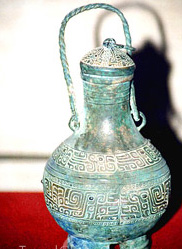| Legole.Com Discover china. Explore the beauty and wonder of the land, people, and culture of China. |
 |
|
|
 |
| |
| 21st - 16th century BC |
 At the later period of the Primitive Society, the Abdication System was widely used by the tribes. When Yu the Great became old, he had planned to abdicate his throne to Boyi, who had assisted him in his great work of flood control. However, after Yu died, his son Qi, took advantage of his privileged situation and power, killed Boyi and succeeded to the throne. The hereditary dynasty established by Qi is known as the Xia Dynasty, which was the first dynasty in China. From that time on a Hereditary System replaced the Abdication System and China became a society based on slavery. At the later period of the Primitive Society, the Abdication System was widely used by the tribes. When Yu the Great became old, he had planned to abdicate his throne to Boyi, who had assisted him in his great work of flood control. However, after Yu died, his son Qi, took advantage of his privileged situation and power, killed Boyi and succeeded to the throne. The hereditary dynasty established by Qi is known as the Xia Dynasty, which was the first dynasty in China. From that time on a Hereditary System replaced the Abdication System and China became a society based on slavery.
However, from Sima Qian on, historians in later dynasties mostly regarded Yu the Great as the founder of the Xia Dynasty. The Xia Dynasty lasted over 400 years from the 21st century BC to the 17th century BC. In total there were seventeen kings over fourteen generations.
Although the ideal Society of Great Harmony was replaced with an autocratic regime, the establishment of the Xia Dynasty represents a huge advancement in the evolution of China.
In this new kind of social system, the ruling class inevitably lacked the necessary experience to govern the country. During their four-hundred-year reign, internal conflicts and power struggles continually caused trouble for the dynastic rulers. At the end of the Xia Dynasty, external aggression and internal conflict became ever more serious. Upon his succession to the throne, Jie, regardless of the chaos within the state, lived for pleasure. He cavorted with his concubines all day and night while ordering the construction of many gorgeous palaces for his personal enjoyment. Tang, a small state, led a revolution which resulted in the overthrow of the despotic Jie. The Xia Dynasty was no more.
Due to a lack of historical records, there had been some doubt about the existence of the Xia Dynasty. However, discoveries relating to the Longshan Culture and the Erlitou Culture provide rich references for the study of the mysterious Xia.
|
|
|
 |
|
